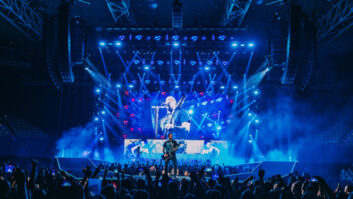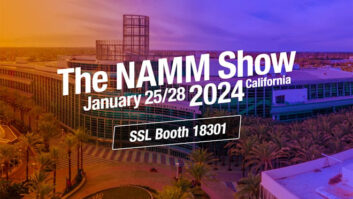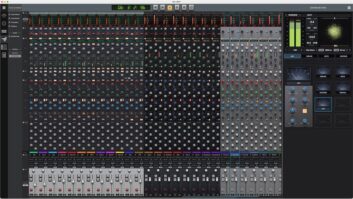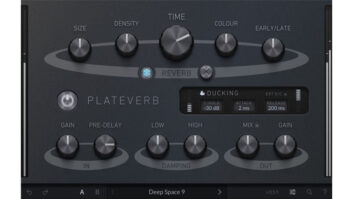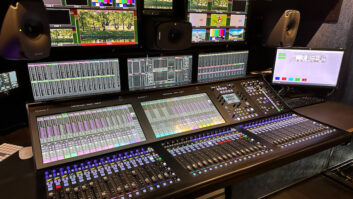Volbeat may have been founded in Copenhagen, Denmark, but the heavy metal band is known around the globe—as its headlining run through North America proved this past spring. Providing audio for the journey was Denmark-based Victory Tour Production, with support from Montreal-based Solotech, and at the controls were FOH engineer Mads Mikkelsen and monitor engineer Kristoffer Hinrichsen.
Volbeat, seen here at the SK Brandt Centre in Regina, Canada, uses a Meyer Sound Leo and Lyon-based loudspeaker system throughout its world tour. Ever since the band began carrying production, Mikkelsen has opted for DiGiCo consoles and currently uses a well-connected SD10: “I am mainly running my desk as a big patchbay to get in and out of Waves—all my dynamic processing, most of my EQ and all of my effects are done in Waves MultiRack SoundGrid.” As a result, MADI port 1 is connected via a DiGiGrid MGB interface to an Apple Macintosh running Waves Tracks Live—used for recording “official bootlegs” and material for virtual soundchecks—and Rational Acoustics’ Smaart v.7 software. Meanwhile, MADI port 2 connects via another MGB to a SoundGrid Server One, used to run Waves plug-ins. Another Mac Mini is outfitted with both SD10 software and 10EaZy sound level measurement software.

Key among the plug-ins is the C6 Multiband Compressor, used on the bass and electric guitars, vocal and LR main buss. “I also have some C6 just processing key vocal channels, to sidechain into my main vocal gates, because Volbeat is extremely loud on stage and I need to gate the vocals a bit to get rid of the bleed,” he noted. Other Waves plug-ins on hand include MaxxBass for adding heft to guitars and bass; the SSL G-Master Buss Compressor on drums; Renaissance Reverb on snare; TrueVerb on toms and vocals; and Doubler and H-Delay on vocals, too.
“Then there is InPhase,” he said. “I use that to align the kick trigger with the kick mic, align the top and bottom snare mics, and to widen the stereo image of the guitars. I do not pan the guitars— that way you won’t miss some guitars if you are only listing to one cluster of speakers, but you still get a big ‘wrap around your head’ mix when you are in the center of the venue or sitting between the main and outer hangs. As a rule, I never pan a mono source—it will be lost for half the audience if I start to pan stuff left or right.”
FOH engineer Mads Mikkelsen mixes every show on a well-equipped DiGiCo SD10 console. The band uses similar Meyer Sound PAs around the globe. “Since the band is an international artist, we needed an international speaker manufacturer to make sure we get the same quality all over the world,” said Mikkelsen. That means Volbeat is heard through a Meyer Sound Leo and Lyon-based loudspeaker system, comprised of dual front hangs that each sport 12 Leo-Ms over two Lyon-M main and Lyon-W wide-coverage line array loudspeakers. Meanwhile, two-dozen 1100-LFC low-frequency control elements are split between flown and ground-stacked arrays, side hangs each have eight Leo-Ms over two Lyon-W loudspeakers, and front fill is provided by eight M’elodie loudspeakers. Keeping tabs on all that is a Galileo loudspeaker management system with one Galileo 616 and three Galileo Callisto 616 array processors for drive and optimization.

Even though some band-members use Sennheiser in-ear systems monitors, most of the mixes Hinrichsen creates on his SD10 at stageside are delivered by a plethora of Meyer boxes, including 16 MJF-212A stage monitors, four 1100-LFC elements, one 500-HP subwoofer and six JM-1P loudspeakers. The result is, as Mikkelsen put it, “Loud! The center vocal position is around 125 dB, just vocal. I have to work around the fact that there is a lot of noise on stage; that’s actually one of the reasons I like to do a L-R sub configuration under the main hang—so I have as few delay times in the system as possible because I have so many different times coming from guitar speakers, sidefill, wedges and so on.”
The band has been on Audix mics since day one, said Mikkelsen: “We use the OM7 for vocals—it has a very narrow pattern so you have to get in really close, but you can be extremely loud on stage before feedback and that is something we need with this band.” Drums are captured with a D6 on the kick, I5 and D3 on the snare, Micro-D and Adx51 on cymbals, and D2s, D4s and D6s on toms, internally mounted to prevent stage bleed. Guitars and bass come direct out of Palmer PDI03s and a TC Electronic bass amp for the same reason.
All of that adds up to a signature sound that Mikkelsen aims for at every show. “We are not in a studio,” he said. “This is very much a live band, so I mix it to sound live—but I try very much to make it consistent every night. The fans that come to hear and see Volbeat love rock and roll, and so do I, so I try to make it a big-sounding rock show. I make sure that all the little guitar riffs and lyrics are audible, but I still make sure that the audience is blown away!”
Meyer Sound
Meyersound.com
Audix
Audixusa.com
DiGiCo
Digico.biz
